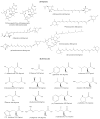Morphological, Toxicological, and Biochemical Characterization of Two Species of Gambierdiscus from Bahía de La Paz, Gulf of California
- PMID: 39330303
- PMCID: PMC11433345
- DOI: 10.3390/md22090422
Morphological, Toxicological, and Biochemical Characterization of Two Species of Gambierdiscus from Bahía de La Paz, Gulf of California
Abstract
We describe five new isolates of two Gambierdiscus species from Bahía de La Paz in the southern Gulf of California. Batch cultures of Gambierdiscus were established for morphological characterization using light microscopy (LM) and scanning electron microscopy (SEM). Pigment and amino acid profiles were also analyzed using high-performance liquid chromatography (HPLC-UV and HPLC-DAD). Finally, toxicity (CTX-like and MTX-like activity) was evaluated using the Artemia salina assay (ARTOX), mouse assay (MBA), marine fish assay (MFA), and fluorescent receptor binding assay (fRBA). These strains were identified as Gambierdiscus cf. caribaeus and Gambierdiscus cf. carpenteri. Toxicity for CTX-like and MTX-like activity was confirmed in all evaluated clones. Seven pigments were detected, with chlorophyll a, pyridine, Chl2, and diadinoxanthin being particularly noteworthy. For the first time, a screening of the amino acid profile of Gambierdiscus from the Pacific Ocean was conducted, which showed 14 amino acids for all strains except histidine, which was only present in G. cf. caribeaus. We report the presence of Gambierdiscus and Fukuyoa species in the Mexican Pacific, where ciguatera fish poisoning (CFP) cases have occurred.
Keywords: Gambierdiscus; Gulf of California; amino acids; ciguatera; ciguatoxins; pigments; toxicity.
Conflict of interest statement
The authors declare no conflicts of interest.
Figures












Similar articles
-
Toxicity screening of 13 Gambierdiscus strains using neuro-2a and erythrocyte lysis bioassays.Harmful Algae. 2017 Mar;63:173-183. doi: 10.1016/j.hal.2017.02.005. Epub 2017 Mar 9. Harmful Algae. 2017. PMID: 28366392
-
Ciguatoxin-Producing Dinoflagellate Gambierdiscus in the Beibu Gulf: First Report of Toxic Gambierdiscus in Chinese Waters.Toxins (Basel). 2021 Sep 10;13(9):643. doi: 10.3390/toxins13090643. Toxins (Basel). 2021. PMID: 34564646 Free PMC article.
-
Ciguatoxicity of Gambierdiscus and Fukuyoa species from the Caribbean and Gulf of Mexico.PLoS One. 2017 Oct 18;12(10):e0185776. doi: 10.1371/journal.pone.0185776. eCollection 2017. PLoS One. 2017. PMID: 29045489 Free PMC article.
-
Ciguatera Fish Poisoning in the Caribbean Sea and Atlantic Ocean: Reconciling the Multiplicity of Ciguatoxins and Analytical Chemistry Approach for Public Health Safety.Toxins (Basel). 2023 Jul 10;15(7):453. doi: 10.3390/toxins15070453. Toxins (Basel). 2023. PMID: 37505722 Free PMC article. Review.
-
Ciguatera Fish Poisoning: The Risk from an Aotearoa/New Zealand Perspective.Toxins (Basel). 2020 Jan 15;12(1):50. doi: 10.3390/toxins12010050. Toxins (Basel). 2020. PMID: 31952334 Free PMC article. Review.
Cited by
-
Automatic MS/MS Data Mining Strategy for Rapid Screening of Polyether Toxins Derived from Gambierdiscus Species.Anal Chem. 2025 Mar 18;97(10):5643-5652. doi: 10.1021/acs.analchem.4c06440. Epub 2025 Mar 4. Anal Chem. 2025. PMID: 40035825 Free PMC article.
References
-
- FAO. WHO . Report of the Expert Meeting on Ciguatera Poisoning: Rome, 19–23 November 2018. World Health Organization; Rome, Italy: 2020. Food Safety and Quality No. 9. - DOI
-
- Anderson D.M., Glibert P.M., Burkholder J.M. Harmful algal blooms and eutrophication: Nutrient sources, composition, and consequences. Estuaries. 2002;25:704–726. doi: 10.1007/BF02804901. - DOI
-
- Glibert P.M., Anderson D.A., Gentien P., Granéli E., Sellner K.G. The global, complex phenomena of harmful algal blooms. Oceanography. 2005;18:136–147. doi: 10.5670/oceanog.2005.49. - DOI
-
- Hallegraeff G.M. Ocean climate change, phytoplankton community responses, and harmful algal blooms: A formidable predictive challenge. J. Phycol. 2010;46:220–235. doi: 10.1111/j.1529-8817.2010.00815.x. - DOI
MeSH terms
Substances
LinkOut - more resources
Full Text Sources
Miscellaneous

